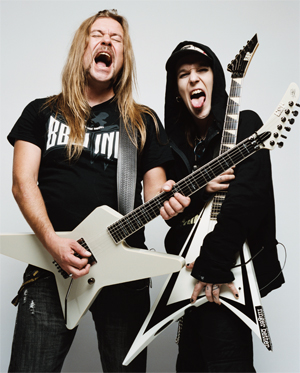Children of Bodom: Slash and Burn

Originally published in Guitar World, February 2009
Children of Bodom's Alexi Laiho and Roope Latvala take you through the twists and turns of their latest offering, "Blooddrunk".
Children of Bodom guitarist Roope Latvala has a method for enduring almost four minutes of relentless, palm-muted, machine-gun 16th-note triplets without his arm cramping up. “I drink a lot of water,” he explains. “It makes up for the electrolytes I lose when I sweat—and when I play like that, I sweat a lot. I’m a sweaty pig,” he says with a laugh, clarifying the point.
Latvala and Alexi Laiho, his coguitarist and Children of Bodom’s frontman, are visiting Guitar World’s New York office, fresh from a trans-Atlantic red-eye, to break down the musical concepts behind “Blooddrunk,” the title track from the Finnish metal group’s latest full-length release.
After establishing the song’s tuning, drop D down one whole step (low to high, C G C F A D), Laiho and Latvala demonstrate the song’s first theme, a rapid, fluid, fourbar triplet-based keyboard melody doubled by Laiho (as shown in bars 5-8 in the transcription, page 130 [Click HERE to purchase the February 2009 issue.]), with muscular rhythm backing provided by Latvala. The trick to mastering Laiho’s part is not so much in nailing the notes cleanly but in making good use of fretboard positions. Indeed, the riff becomes much easier to play once you think of it as a series of two-beat patterns played in specific positions.
The first two beats of each bar are played in 10th position (index finger at the 10th fret), while beats three and four in bars 5–7 are in 12th position. So instead of concentrating on note order first, simply alternate between 10th position (on beats one and two) and 12th (on beats three and four), using proper fingering, and the note order will come more naturally. This melody appears again in section D (page 132) and then once more and a whole step higher in the song’s interlude (section G). Simply take the riff and transpose it two frets higher.
Laiho’s solo (section J, page 135) begins with a series of deliberately dissonant and nasty-sounding unison bends in bars 66 and 67. The guitarist doesn’t shy away from incorporating noise to enhance the mood—note the pick scrape and random “hammer-on from nowhere” in bar 66 and the open G-string dive bombs in bar 67. Laiho then makes use of the F# minor pentatonic box pattern in bar 68, including a wide two-whole-step bend off the A note at the 17th fret on the high E string.
All the latest guitar news, interviews, lessons, reviews, deals and more, direct to your inbox!
The fast run in bar 71 is based on an A Lydian scale pattern (A B C# D# E F# G# A), using the 14th, 16th and 17th frets for the first two beats. Laiho then slides up to the 21st fret in beat three for a cascading A major scale pattern that works its way up the high E string. To execute this single-string run seamlessly, slide up to each highest note in the phrase using your ring finger. For example, when you come to the D at the 22nd fret near the end of beat three, slide into it from the C# at the 21st fret and then again when you reach the 24th fret during beat four. Again, proper fretboard positioning will help you get this phrase under your fingers faster.
The aggressive rhythm parts to “Blooddrunk” are just as integral to the song as its fleet-fingered lead sections. The aforementioned rapid-fire palm-muted 16th-note triplets appear throughout the song, most notably in the chorus (section F in the transcription) and the bridge (section H). Keep your wrist relaxed, and use a pick of at least moderately heavy thickness—you don’t want a wimpy, thin pick bending against the string while you’re trying to articulate a flurry of fast-moving notes.
The song’s bridge (page 134) introduces a different feel, wherein the straight triplet rhythms we’ve been hearing thus far become more complex. Beginning in bar 54, Laiho and Latvala play fast 16th notes at the fourth fret on the detuned sixth string. Such picking requires a balance of finesse and stamina, and to maximize the latter, Laiho suggests emphasizing accents on downbeats. “Say you have a group of four 16th notes—try to accent the first note of the group and hit it harder than the other ones. It’ll groove, but you won’t have to kill yourself just hitting everything as hard as you can all the time.”
Adds Latvala, “Even if you can only give yourself microsecond breaks, it kind of presses the ‘reset’ button.”
To get through this section relatively unscathed, think of each beat as being comprised of three eighth-note triplets. Pick each of these triplets with downstrokes, and be sure to accent them per Laiho’s advice and use relaxed upstrokes to pick any 16th notes that fall between the cracks. For example, for the first two beats of bar 54, the picking order would be “down down-up-down-up down down down” (downstrokes are italicized to indicate accents). Picking in this fashion should help propel the groove while staving off fatigue in your picking arm.
On beats three and four of bars 55 and 57, Laiho and Latvala launch into fast runs based on the # natural minor scale (F# G# A B C# D E F#). Again, be mindful of fretboard positioning to facilitate accuracy.
